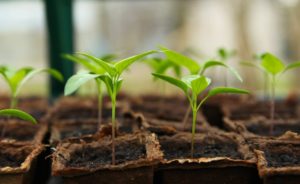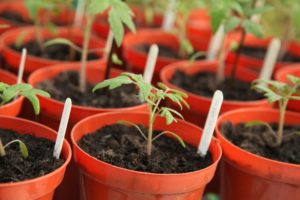Follow These Tips for Seed Starting Success!
Start seeds 7 weeks before their normal planting dates. Example: Tomatoes and peppers are safely planted around May 30th; start the seeds around April 12th. Broccoli, cabbage and other cool season crops are usually planted the last week of April; start the seeds about March 15th.
Follow all instructions on the seed pack. Seeds will vary in:
- Germination time
- Planting depth
- Pre-treatment requirements such as Soaking, Scarification (nicking the shell), and Stratification (chilling)
- If they need light or darkness for germination keep notes!
Save the empty packs for a reference and as an identification marker.
 Use fresh seed for best results. Leftover seed can be tested by sprinkling 10 seeds out between 2 pieces of wet paper towel set on a dish and placed on top of you refrigerator. Check them daily. Keep the towels moist. At least 6 – 7 seeds should sprout by expected germination time, if not it’s time for fresh seed!
Use fresh seed for best results. Leftover seed can be tested by sprinkling 10 seeds out between 2 pieces of wet paper towel set on a dish and placed on top of you refrigerator. Check them daily. Keep the towels moist. At least 6 – 7 seeds should sprout by expected germination time, if not it’s time for fresh seed!
Growing containers should be at least 2 inches deep. Jiffy seed starting kits work great! Clean any used containers with 1 part bleach to 8 parts hot water. Make sure all containers have good drainage.
Wet planting mix before filling containers. Always use water that has set out overnight, this evaporates the chlorine and sets the water to room temperature. Use tepid water for all growing phases of your plants, it makes a big difference!
The magic ‘sprouting’ number is 72 degrees for most plants. Bottom heat can be provided by a germination station. A clip-on utility light with a 100 watt bulb positioned near the bottom of the containers will work. Leave the light on until germination. (If seeds require darkness for germination cover them with cardboard)
A sunny window is not enough light alone for growing. Plants tend to stretch and become leggy and weak. LED and/or Fluorescent lights work well and are economical to use. Place your seedlings 2 inches from the bulbs. Healthy little plants need 14 – 16 hours of light per day. Rotate plantings, the middle tubes produce the most light. Keep light fixtures clean, replace bulbs yearly. When possible furnish seedlings with natural sunlight along with artificial light.
 Have your plant markers ready when you plant.
Have your plant markers ready when you plant.
Growing medium should never be allowed to dry out! Mist containers with a spray bottle or let them sit in a pan filled with tepid water for 30 minutes, they’ll take up water evenly from the bottom without disturbing seed placement. Maintain a watering routine.
Sterile growing mix, clean containers, good seed and air circulation prevent dampening off and other fungal diseases. Set up a small fan in your growing area; this will also strengthen seedlings.
Thickly sown seeds need thinning, remove excess plants with a small pair of scissors.
Remember to take notes and some pictures for your garden log.


